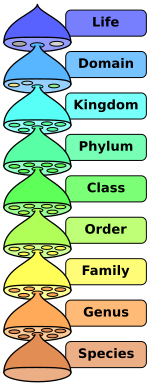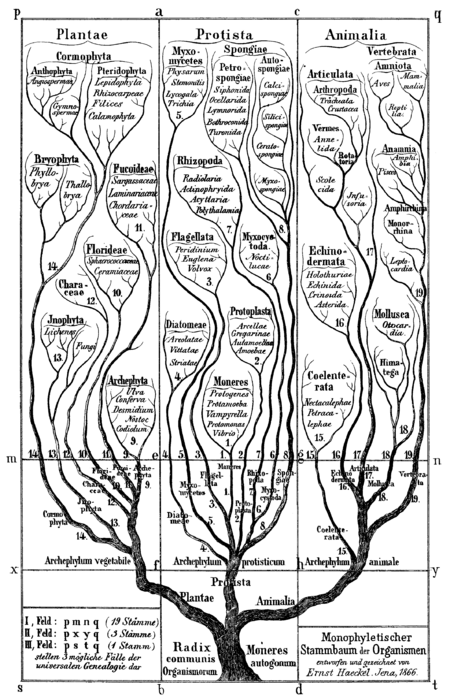Kingdom (biology) facts for kids
In biology, a kingdom is a very big group used to classify living things. Think of it like a major division in a huge library of all life on Earth! It's the second highest level of grouping, right below a domain. Kingdoms are then split into smaller groups called phyla.
Different parts of the world sometimes teach about a slightly different number of kingdoms. For example, some textbooks in the United States and Canada often talk about six kingdoms: Animals, Plants, Fungi, Protists, Archaea, and Bacteria. But in other places, like the United Kingdom, they might teach about five kingdoms: Animals, Plants, Fungi, Protists, and Monera (which includes bacteria).
Scientists today sometimes use newer ways to group living things. These methods focus on how closely related organisms are through their shared ancestors. Because of this, the idea of "kingdoms" as strict groups is sometimes changed or even replaced in very modern classifications. You might also hear the terms flora (for plants), fauna (for animals), and funga (for fungi) to describe the life found in a specific area or time.
Contents
What is a Kingdom?
When Carl Linnaeus first created his system for naming and classifying living things in 1735, "kingdom" was the highest level. Below it were other main groups: class, order, genus, and species. Later, scientists added more levels, like phylum (or division), and family. In 1990, the even higher level of domain was added above kingdom.
Sometimes, you might hear about "subkingdoms" or "infrakingdoms." These are even smaller groups that fit just below a main kingdom, helping scientists organize life in more detail.
How Kingdoms Were Discovered
Early Ideas: Two Kingdoms
People have been trying to sort living things into groups for a very long time. Ancient thinkers like Aristotle (who lived around 384–322 BC) grouped animals. His student, Theophrastus, did the same for plants.
Carl Linnaeus, who created the modern system for naming living things in 1735, officially recognized two kingdoms of life: the Animal Kingdom and the Plant Kingdom. Interestingly, Linnaeus also had a third kingdom for minerals, but that's not used in biology today!
In 1674, a scientist named Antonie van Leeuwenhoek discovered tiny, single-celled organisms using his new microscope. Before him, no one even knew these microscopic creatures existed! At first, these tiny organisms were just put into the animal or plant kingdoms.
Adding More Kingdoms
As microscopes got better, scientists saw more differences between living things. In 1860, John Hogg suggested a third kingdom called Protoctista. This new group included all the tiny, simpler organisms that didn't quite fit as animals or plants.
Later, scientists realized that some cells have a clear center called a nucleus, while others don't. Cells with a nucleus are called eukaryotes, and cells without one are called prokaryotes. This was a huge discovery!
In 1938, Herbert F. Copeland proposed a four-kingdom system. He created a new kingdom called Monera specifically for all the prokaryotic organisms (those without a nucleus).
In the 1960s, scientists like Roger Stanier and C. B. van Niel helped make the difference between prokaryotes and eukaryotes very popular. They even suggested a level above kingdoms, calling them "superkingdoms" or "empires." This led to the idea of a three-domain system later on, which includes Archaea, Bacteria, and Eukaryota.
Scientists also noticed that fungi (like mushrooms and molds) were very different from plants, even though they were often grouped together. They don't make their own food like plants do. So, in 1969, Robert Whittaker proposed a five-kingdom system by adding a separate kingdom for the Fungi. This five-kingdom system became very popular and is still used in many places today. It mainly groups organisms based on how they get their food.
In 1977, Carl Woese and his team suggested a six-kingdom model. In this system, the Monera kingdom was split into two new kingdoms: Bacteria and Archaea. This six-kingdom model is often found in high school biology textbooks in the US.
While some scientists have suggested even more kingdoms (like seven or eight), most school textbooks today stick to either the five- or six-kingdom systems.
| Linnaeus 1735 |
Haeckel 1866 |
Chatton 1925 |
Copeland 1938 |
Whittaker 1969 |
Woese et al. 1977 |
Woese et al. 1990 |
Cavalier-Smith 1993 |
Cavalier-Smith 1998 |
|---|---|---|---|---|---|---|---|---|
| 2 kingdoms | 3 kingdoms | 2 empires | 4 kingdoms | 5 kingdoms | 6 kingdoms | 3 domains | 8 kingdoms | 6 kingdoms |
| (not treated) | Protista | Prokaryota | Monera | Monera | Eubacteria | Bacteria | Eubacteria | Bacteria |
| Archaebacteria | Archaea | Archaebacteria | ||||||
| Eukaryota | Protoctista | Protista | Protista | Eucarya | Archezoa | Protozoa | ||
| Protozoa | ||||||||
| Chromista | Chromista | |||||||
| Vegetabilia | Plantae | Plantae | Plantae | Plantae | Plantae | Plantae | ||
| Fungi | Fungi | Fungi | Fungi | |||||
| Animalia | Animalia | Animalia | Animalia | Animalia | Animalia | Animalia |
Grouping life into kingdoms is a helpful way to understand the huge variety of organisms on Earth. However, scientists are always learning new things, and our understanding of how living things are related keeps changing!
Are Viruses Living?
Viruses are very tiny things that can make you sick, but scientists often debate if they should be included in the "tree of life" with other living organisms.
Some reasons why viruses might NOT be considered living:
- They need a host cell (like one of your cells!) to make copies of themselves. They can't do it on their own.
- They don't have their own metabolism, which means they don't produce energy or carry out life processes like other living things.
On the other hand, some scientists argue that viruses SHOULD be included:
- Scientists have found some unusually large and complex viruses, like Mimivirus, that have genes similar to those found in cells. This makes them seem more "alive."
The International Committee on Taxonomy of Viruses does use the term "kingdom" to classify viruses, but it's part of their own special system for viruses, which is different from the kingdoms used for animals, plants, and other organisms.
See also
 In Spanish: Reino (biología) para niños
In Spanish: Reino (biología) para niños



